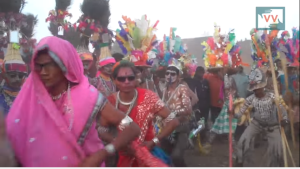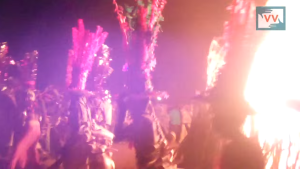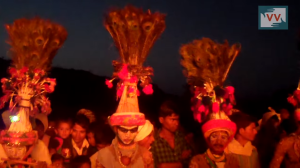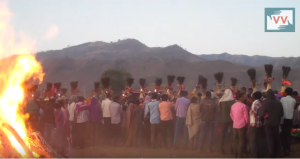The peace and tranquility of the villages on the foothills Satpura hill ranges in Maharashtra had taken a back seat for the past 15 days, as the atmosphere was charged with singing and dancing. Members of the Bhil tribe of the Satpura Hill regions from Maharashtra, Gujarat and Madhya Pradesh had gathered in Asli village of Nandurbar district in Maharashtra to pay their respect to Holi Mata on the occasion of Holi festival.

Holi is considered the biggest festival of the region, signifying fertility in women and agriculture. Unlike the popular Holi played in most parts of India where everyone douses each other in colours and dance on Bollywood songs; the Holi celebrations of Bhils have changed little over the 700 years old. The original residents of the Satpura ranges, these tribals where relocated to nearby villages as many of their villages were claimed by the Narmada dam. Though their homes were snatched away from them for ‘development’, the tribals vowed that they will keep their ancient culture alive. Journalists, researchers and activists such as Medha Patkar join the celebrations to observe and celebrate the resilience and culture of these tribes.


The fifteen-day celebration traverses hundreds of villages in the district, a few villages at one day. During these days, men dressed as women and as wild animals dance with glee in hordes of hundreds to the tunes of folk instruments, as other men adorn colourful headgears made out of paper, weapons, etc perform various different traditional dance forms like Molgi. Women too join these festivals as they dance along with men to celebrate fertility. “Only men who need to fulfill a vow to goddess Holika can dress up as wild animals and women and dance in these processions. To completely appease the goddess, they have to go to five different villages in the region and dance along with the locals there,” explains Chetan Salve.
At the end of fifteen days, on 24th March, the day of Holi, the residents of Kathi village erected a 40-50ft bamboo in the centre of the village. The tradition demands that the bamboo be brought by the tribals from Gujarat travel around 350 km which is specially grown in the deep forests. “They didn’t cut this bamboo. They prayed to it and dug it up from the ground. There is an ancient pit of at least 5ft in the ground where the devotees fix this bamboo with their hands, without using any equipment,” Chetan tells us. The wood for the Holika Dahan was contributed by all tribals present there with the Bamboo positioned in the centre of the dahan.

The gathering of men and women danced till the wee hours of the morning 25th and just before the sun came up, they lit the Holi, praying to the Goddess for rains and good crop.
Pay By the Cellular Gambling enterprises In britain, Finest Pay By Mobile phone Gambling enterprises
Pay By the Cellular Gambling enterprises In britain, Finest Pay By Mobile phone Gambling enterprises Articles Best Uk Online casino games What are the Almost every other Certificates An excellent Uk Gambling establishment Can have To Getting Courtroom? Faqs For the Greatest Cellular Casinos In the uk The most popular...
Fighting for Change: The Story of Bihar-Based Journalist Amir Abbas
Inspiration can come from many sources, but one of the most powerful is seeing someone walk the path before you. Our Community Correspondent, Syed Amir Abbas found his inspiration in Stalin K., the founding director of Video Volunteers. “I met Stalin at VV’s national meet in 2017 and I...

